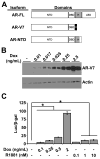Androgen receptor and its splice variant, AR-V7, differentially regulate FOXA1 sensitive genes in LNCaP prostate cancer cells
- PMID: 25008967
- PMCID: PMC4160387
- DOI: 10.1016/j.biocel.2014.06.013
Androgen receptor and its splice variant, AR-V7, differentially regulate FOXA1 sensitive genes in LNCaP prostate cancer cells
Abstract
Prostate cancer (PCa) is an androgen-dependent disease, and tumors that are resistant to androgen ablation therapy often remain androgen receptor (AR) dependent. Among the contributors to castration-resistant PCa are AR splice variants that lack the ligand-binding domain (LBD). Instead, they have small amounts of unique sequence derived from cryptic exons or from out of frame translation. The AR-V7 (or AR3) variant is constitutively active and is expressed under conditions consistent with CRPC. AR-V7 is reported to regulate a transcriptional program that is similar but not identical to that of AR. However, it is unknown whether these differences are due to the unique sequence in AR-V7, or simply to loss of the LBD. To examine transcriptional regulation by AR-V7, we have used lentiviruses encoding AR-V7 (amino acids 1-627 of AR with the 16 amino acids unique to the variant) to prepare a derivative of the androgen-dependent LNCaP cells with inducible expression of AR-V7. An additional cell line was generated with regulated expression of AR-NTD (amino acids 1-660 of AR); this mutant lacks the LBD but does not have the AR-V7 specific sequence. We find that AR and AR-V7 have distinct activities on target genes that are co-regulated by FOXA1. Transcripts regulated by AR-V7 were similarly regulated by AR-NTD, indicating that loss of the LBD is sufficient for the observed differences. Differential regulation of target genes correlates with preferential recruitment of AR or AR-V7 to specific cis-regulatory DNA sequences providing an explanation for some of the observed differences in target gene regulation.
Keywords: Androgen receptor; Cell biology; Nuclear receptors; Prostate cancer; Transcription.
Copyright © 2014 Elsevier Ltd. All rights reserved.
Figures







Similar articles
-
Differential regulation of metabolic pathways by androgen receptor (AR) and its constitutively active splice variant, AR-V7, in prostate cancer cells.Oncotarget. 2015 Oct 13;6(31):31997-2012. doi: 10.18632/oncotarget.5585. Oncotarget. 2015. PMID: 26378018 Free PMC article.
-
Melatonin Inhibits Androgen Receptor Splice Variant-7 (AR-V7)-Induced Nuclear Factor-Kappa B (NF-κB) Activation and NF-κB Activator-Induced AR-V7 Expression in Prostate Cancer Cells: Potential Implications for the Use of Melatonin in Castration-Resistant Prostate Cancer (CRPC) Therapy.Int J Mol Sci. 2017 May 31;18(6):1130. doi: 10.3390/ijms18061130. Int J Mol Sci. 2017. PMID: 28561752 Free PMC article.
-
Mechanisms of the androgen receptor splicing in prostate cancer cells.Oncogene. 2014 Jun 12;33(24):3140-50. doi: 10.1038/onc.2013.284. Epub 2013 Jul 15. Oncogene. 2014. PMID: 23851510 Free PMC article.
-
Molecular Origin, Expression Regulation, and Biological Function of Androgen Receptor Splicing Variant 7 in Prostate Cancer.Urol Int. 2021;105(5-6):337-353. doi: 10.1159/000510124. Epub 2020 Sep 21. Urol Int. 2021. PMID: 32957106 Review.
-
Androgen receptor variant-driven prostate cancer: clinical implications and therapeutic targeting.Prostate Cancer Prostatic Dis. 2016 Sep;19(3):231-41. doi: 10.1038/pcan.2016.17. Epub 2016 May 17. Prostate Cancer Prostatic Dis. 2016. PMID: 27184811 Free PMC article. Review.
Cited by
-
Androgen Receptor and Its Splicing Variant 7 Expression in Peripheral Blood Mononuclear Cells and in Circulating Tumor Cells in Metastatic Castration-Resistant Prostate Cancer.Cells. 2020 Jan 14;9(1):203. doi: 10.3390/cells9010203. Cells. 2020. PMID: 31947623 Free PMC article.
-
Role of androgen receptor splice variants, their clinical relevance and treatment options.World J Urol. 2020 Mar;38(3):647-656. doi: 10.1007/s00345-018-02619-0. Epub 2019 Jan 19. World J Urol. 2020. PMID: 30659302 Review.
-
Beyond Prostate Cancer: An Androgen Receptor Splice Variant Expression in Multiple Malignancies, Non-Cancer Pathologies, and Development.Biomedicines. 2023 Aug 7;11(8):2215. doi: 10.3390/biomedicines11082215. Biomedicines. 2023. PMID: 37626712 Free PMC article. Review.
-
Nuclear Receptor Corepressor 1 Expression and Output Declines with Prostate Cancer Progression.Clin Cancer Res. 2016 Aug 1;22(15):3937-49. doi: 10.1158/1078-0432.CCR-15-1983. Epub 2016 Mar 11. Clin Cancer Res. 2016. PMID: 26968201 Free PMC article.
-
Increased transcription and high translation efficiency lead to accumulation of androgen receptor splice variant after androgen deprivation therapy.Cancer Lett. 2021 Apr 28;504:37-48. doi: 10.1016/j.canlet.2020.12.037. Epub 2021 Feb 6. Cancer Lett. 2021. PMID: 33556543 Free PMC article.
References
-
- Agoulnik IU, Krause WC, Bingman WE, Rahman HT, Amrikachi M, Ayala GE, et al. Repressors of androgen and progesterone receptor action. J Biol Chem. 2003 Aug 15;278(33):31136–48. - PubMed
-
- Agoulnik IU, Vaid A, Bingman WE, Erdeme H, Frolov A, Smith CL, et al. Role of SRC-1 in the promotion of prostate cancer cell growth and tumor progression. Cancer Res. 2005 Sep 1;65(17):7959–67. - PubMed
-
- Agoulnik IU, Vaid A, Nakka M, Alvarado M, Bingman WE, Erdem H, et al. Androgens modulate expression of transcription intermediary factor 2, an androgen receptor coactivator whose expression level correlates with early biochemical recurrence in prostate cancer. Cancer Res. 2006 Nov 1;66(21):10594–602. - PubMed
-
- Bai W, Weigel NL. Phosphorylation of Ser211 in the chicken progesterone receptor modulates its transcriptional activity. J Biol Chem. 1996 May 31;271(22):12801–6. - PubMed
Publication types
MeSH terms
Substances
Grants and funding
LinkOut - more resources
Full Text Sources
Other Literature Sources
Medical
Research Materials

